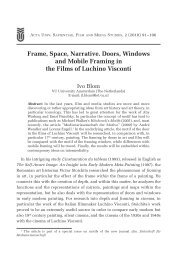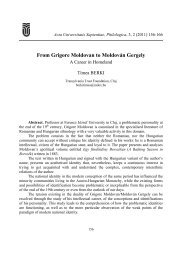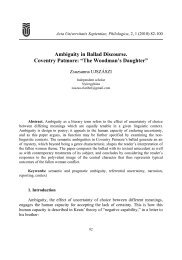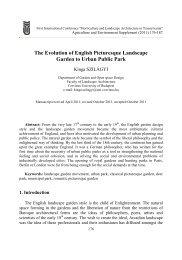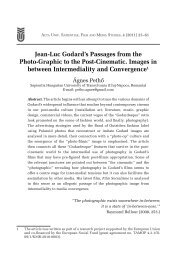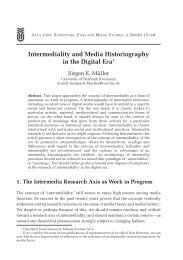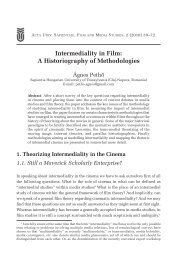Trinitarian Monastery Gardens in the 18 Century Hungary - Acta ...
Trinitarian Monastery Gardens in the 18 Century Hungary - Acta ...
Trinitarian Monastery Gardens in the 18 Century Hungary - Acta ...
You also want an ePaper? Increase the reach of your titles
YUMPU automatically turns print PDFs into web optimized ePapers that Google loves.
First International Conference “Horticulture and Landscape Architecture <strong>in</strong> Transylvania”<br />
Agriculture and Environment Supplement (2011) 80-92<br />
<strong>Tr<strong>in</strong>itarian</strong> <strong>Monastery</strong> <strong>Gardens</strong> <strong>in</strong> <strong>the</strong> <strong>18</strong> th <strong>Century</strong><br />
<strong>Hungary</strong><br />
Mária KLAGYIVIK<br />
Department of Garden Art<br />
Faculty of Landscape Architecture<br />
Corv<strong>in</strong>us University of Budapest<br />
e-mail: maria.klagyivik@uni-corv<strong>in</strong>us.hu<br />
Manuscript received April 2011; revised August 2011, accepted August 2011<br />
Abstract: The formation of <strong>Tr<strong>in</strong>itarian</strong> gardens was determ<strong>in</strong>ed by several factors: by<br />
<strong>the</strong> type of religious order (mendicant) which resulted <strong>in</strong> a modest lifestyle, as well as by<br />
<strong>the</strong>ir ma<strong>in</strong> supporters, often specify<strong>in</strong>g <strong>the</strong> orig<strong>in</strong> or layout of <strong>the</strong>ir monasteries. Generally<br />
different functions like farm<strong>in</strong>g and recreation were mixed <strong>in</strong> <strong>the</strong>ir gardens. Yet, historical<br />
sources like period depictions and descriptions seem contradictory, <strong>the</strong> clarification of<br />
which is <strong>the</strong> primary aim of <strong>the</strong> paper. The research exam<strong>in</strong>es <strong>the</strong>ir quondam monasteries <strong>in</strong><br />
Illava (Ilava, SK), Pozsony (Bratislava, SK), Nagyszombat (Trnava, SK), Óbuda,<br />
Budakeszi, Eger, Sárospatak and Gyulafehérvár (Alba Iulia, RO).<br />
Keywords: garden history, monastery gardens, historic gardens<br />
1. Introduction<br />
<strong>Monastery</strong> gardens are peculiar cultural landscapes, represent<strong>in</strong>g <strong>the</strong> designed<br />
and associative types of cultural landscapes all <strong>in</strong> one. These gardens had been<br />
established for functional and contemplative aims s<strong>in</strong>ce <strong>the</strong> Middle Ages. The<br />
surround<strong>in</strong>g walls of monasteries had existed s<strong>in</strong>ce <strong>the</strong> time of St. Pachomius (292-<br />
348 AD) and became a characteristic feature of monasteries onwards [1]. The walls<br />
certa<strong>in</strong>ly limited <strong>the</strong> space, <strong>the</strong>refore, it was general to mix <strong>the</strong> different functions<br />
of places, like plant<strong>in</strong>g an orchard <strong>in</strong> <strong>the</strong> cemetery garden. Pleasure gardens also<br />
developed this way, by <strong>the</strong> beautification of vegetable or herb gardens.<br />
80
<strong>Tr<strong>in</strong>itarian</strong> <strong>Monastery</strong> <strong>Gardens</strong> <strong>in</strong> <strong>the</strong> <strong>18</strong> th <strong>Century</strong> <strong>Hungary</strong> 81<br />
The <strong>Tr<strong>in</strong>itarian</strong>s, f<strong>in</strong>d<strong>in</strong>g <strong>the</strong>ir way to <strong>Hungary</strong> under <strong>the</strong> Turkish Rule (Fig. 1.)<br />
[2], belonged to one of <strong>the</strong> most ancient type of religious orders, <strong>the</strong> mendicant<br />
orders, and as such, <strong>the</strong>refore, <strong>the</strong>y depended mostly on <strong>the</strong> charity of <strong>the</strong> people.<br />
The peculiarity of <strong>Tr<strong>in</strong>itarian</strong> gardens lies <strong>in</strong> that even though <strong>the</strong>y are supposed to<br />
be typical modest monastery gardens, <strong>the</strong>re exist some engrav<strong>in</strong>gs which depict<br />
quite a huge area next to <strong>the</strong> build<strong>in</strong>gs filled with decorative garden elements. The<br />
aim of this paper is to resolve this apparent contradiction and thus present<br />
<strong>Tr<strong>in</strong>itarian</strong> garden art.<br />
2. Materials and Methods<br />
Figure 1: <strong>Tr<strong>in</strong>itarian</strong> monasteries <strong>in</strong> <strong>Hungary</strong>, <strong>18</strong> th c.<br />
The National Archives of <strong>Hungary</strong> keeps many files from <strong>the</strong> time of <strong>the</strong><br />
dissolution of <strong>the</strong> monasteries, of which <strong>the</strong> <strong>in</strong>ventories <strong>in</strong>clude <strong>in</strong>formation<br />
concern<strong>in</strong>g <strong>the</strong> gardens as well [3]. Besides, a series of engrav<strong>in</strong>gs depict<strong>in</strong>g <strong>the</strong><br />
monasteries has also been essential source [4], s<strong>in</strong>ce hardly any o<strong>the</strong>r imagery<br />
sources exist from <strong>the</strong> <strong>18</strong> th century concern<strong>in</strong>g <strong>the</strong>se monasteries. Fur<strong>the</strong>rmore, site<br />
plans and maps also hold useful <strong>in</strong>formation regard<strong>in</strong>g <strong>the</strong> monasteries [5].<br />
The historical research of monastery gardens already has a long tradition,<br />
especially <strong>in</strong> <strong>the</strong> German-speak<strong>in</strong>g countries [6]. However, <strong>Tr<strong>in</strong>itarian</strong> monastery<br />
gardens are usually not mentioned specifically <strong>in</strong> ei<strong>the</strong>r of <strong>the</strong>m, hence <strong>the</strong> research<br />
has basically no antecedents <strong>in</strong> <strong>Hungary</strong> as well. Although <strong>the</strong> order was quite<br />
determ<strong>in</strong><strong>in</strong>g <strong>in</strong> <strong>the</strong> <strong>18</strong> th century, and also its Baroque architecture was effective, its<br />
short existence last<strong>in</strong>g no more than 90 years made it be overlooked. Yet, works like
82 M. Klagyivik<br />
Ferenc Fallenbüchl’s comprehensive historical description of <strong>the</strong> Hungarian activity<br />
of <strong>the</strong> order [7], and also o<strong>the</strong>rs treat<strong>in</strong>g <strong>the</strong> history of certa<strong>in</strong> <strong>Tr<strong>in</strong>itarian</strong> monasteries<br />
[8] have provided great assistance <strong>in</strong> <strong>the</strong> research of <strong>the</strong>ir gardens alike.<br />
3. Results and discussions<br />
The formation of <strong>Tr<strong>in</strong>itarian</strong> gardens was determ<strong>in</strong>ed by several factors. The<br />
order belonged to <strong>the</strong> mendicant orders, which resulted <strong>in</strong> preclud<strong>in</strong>g luxury from<br />
<strong>the</strong>ir lifestyle [9]. Though all Catholic religious orders took <strong>the</strong> solemn vows of<br />
chastity, obedience and poverty, <strong>the</strong> mendicants were particularly strict concern<strong>in</strong>g<br />
<strong>the</strong> last one, <strong>the</strong>refore, <strong>the</strong>y lived <strong>in</strong> even straitened circumstances than for <strong>in</strong>stance<br />
<strong>the</strong>ir monastic associates, which was highly reflected <strong>in</strong> <strong>the</strong>ir gardens as well. Even<br />
though <strong>the</strong> <strong>Tr<strong>in</strong>itarian</strong>s managed to make a large fortune dur<strong>in</strong>g <strong>the</strong>ir activity <strong>in</strong><br />
<strong>Hungary</strong> as a result of <strong>the</strong>ir many benefactors from <strong>the</strong> aristocracy, still most of <strong>the</strong>ir<br />
wealth was used for <strong>the</strong> ransom of captives and for mercy, and hardly any amount<br />
rema<strong>in</strong>ed for <strong>the</strong> upkeep of <strong>the</strong>ir liv<strong>in</strong>g circumstances, <strong>in</strong>clud<strong>in</strong>g <strong>the</strong> gardens.<br />
The order’s ma<strong>in</strong> mediators were <strong>the</strong> Jesuits who not only helped <strong>the</strong>m <strong>in</strong><br />
diverse ways, but also affected <strong>the</strong>m <strong>in</strong> <strong>the</strong>ir way of life. Hence also <strong>the</strong>ir gardens<br />
were built accord<strong>in</strong>g to similar pr<strong>in</strong>cipals. The Jesuits, though also made a fortune<br />
dur<strong>in</strong>g <strong>the</strong> <strong>18</strong> th century and were <strong>the</strong> most <strong>in</strong>fluential order of <strong>the</strong> time, were<br />
specialized on education, and as such, needed to demonstrate a good example to be<br />
followed with <strong>the</strong>ir surround<strong>in</strong>gs, too [10]. Their gardens were modest and<br />
complex, mix<strong>in</strong>g decorative and farm<strong>in</strong>g elements which resulted <strong>in</strong> aes<strong>the</strong>tically<br />
formed vegetable gardens and orchards, reflect<strong>in</strong>g <strong>the</strong> Baroque axiality and<br />
geometrical design.<br />
Never<strong>the</strong>less, a series of engrav<strong>in</strong>gs with depictions of three <strong>Tr<strong>in</strong>itarian</strong><br />
monasteries seem to contradict <strong>the</strong> assumption concern<strong>in</strong>g <strong>the</strong> formation of <strong>the</strong>ir<br />
gardens (Figs. 1-2.). Two of <strong>the</strong>m (Pozsony and Illava) represent huge decorative<br />
gardens, while <strong>the</strong> one of Gyulafehérvár del<strong>in</strong>eates an empty courtyard [11].<br />
The diversity of <strong>the</strong> engrav<strong>in</strong>gs would allow <strong>the</strong> supposition of <strong>the</strong>ir au<strong>the</strong>nticity,<br />
still, <strong>the</strong> two depicted ornamental gardens give rise to a suspicion. The two<br />
monasteries were established at almost <strong>the</strong> same time: Illava <strong>in</strong> 1693, Pozsony <strong>in</strong><br />
1697 [12]. The build<strong>in</strong>g up of <strong>the</strong> monasteries also falls approximately on <strong>the</strong> same<br />
period. It is ra<strong>the</strong>r odd, <strong>the</strong>refore, that while <strong>the</strong> garden of Illava seems to have been<br />
designed <strong>in</strong> <strong>the</strong> spirit of <strong>the</strong> late-Renaissance and early-Baroque garden style (coord<strong>in</strong>ate<br />
garden elements, simultaneous appearance of knot parterres and parterres de<br />
broderie, slightly oblong forms), <strong>the</strong> garden <strong>in</strong> Pozsony already shows <strong>the</strong><br />
characteristics of <strong>the</strong> flourish<strong>in</strong>g Baroque style: strong hierarchy, axial symmetry,<br />
especially long rectangular parterres, predom<strong>in</strong>at<strong>in</strong>g parterres de broderie.
<strong>Tr<strong>in</strong>itarian</strong> <strong>Monastery</strong> <strong>Gardens</strong> <strong>in</strong> <strong>the</strong> <strong>18</strong> th <strong>Century</strong> <strong>Hungary</strong> 83<br />
Figure 2: The monastery of Gyulafehérvár, 1739. /J. a S. Felice (1739), Annalium<br />
Prov<strong>in</strong>ciae….Vienna: S. n., between pp. 687-688./<br />
Figure 3: Ornamental gardens <strong>in</strong> <strong>the</strong> monasteries of Pozsony and Illava, 1739. /J. a S.<br />
Felice (1739), Annalium Prov<strong>in</strong>ciae…Vienna: S. n., between pp. 658-659, 779-780./<br />
One explanation for <strong>the</strong> dissimilarity could be <strong>the</strong> different orig<strong>in</strong> of <strong>the</strong> two<br />
monasteries. The monastery of Illava was built on parts of an old castle which<br />
entailed <strong>the</strong> existence of a previous garden – <strong>the</strong>re existed a water system, a fishpond<br />
and an orchard already at <strong>the</strong> time of <strong>the</strong> foundation [13]. This may have h<strong>in</strong>dered <strong>the</strong><br />
stylistic development, while <strong>the</strong> monastery <strong>in</strong> Pozsony was built after demolish<strong>in</strong>g<br />
everyth<strong>in</strong>g around it, hence a more up-to-date design could be created [14].<br />
The archival documents, however, do not verify <strong>the</strong>se assumptions at all. The<br />
monastery build<strong>in</strong>g of Illava surrounded two quadrangles, <strong>the</strong> smaller of which<br />
conta<strong>in</strong>ed a well. The garden next to <strong>the</strong> build<strong>in</strong>g consisted ma<strong>in</strong>ly of orchards and
84 M. Klagyivik<br />
shady alleys [15]. Accord<strong>in</strong>g to written sources, <strong>the</strong> garden also had diverse beds,<br />
filled with vegetables and ornamental plants alike (<strong>in</strong> plures dist<strong>in</strong>ctus areolas pro<br />
implantatione Olerum, et <strong>in</strong>sem<strong>in</strong>atione Viridarium Servientes). There was also a<br />
skittle (Pyramidarium) used for relaxation by <strong>the</strong> monks and next to it a feed<strong>in</strong>g<br />
place for snails (Limacetum) [16].<br />
While <strong>the</strong> <strong>in</strong>ventories can be considered trustworthy, none of <strong>the</strong> available<br />
imagery sources concern<strong>in</strong>g Illava seems to be really au<strong>the</strong>ntic or mean<strong>in</strong>gful. An<br />
<strong>18</strong> th century plan (Fig. 4.), show<strong>in</strong>g an earlier version of <strong>the</strong> monastery, represents<br />
<strong>the</strong> skittle with an arbour above it, which latter probably did not exist any more at<br />
<strong>the</strong> time of <strong>the</strong> dissolution, as it is not mentioned at all <strong>in</strong> <strong>the</strong> <strong>in</strong>ventory. Fur<strong>the</strong>r<br />
details of <strong>the</strong> garden, however, cannot be specified from this plan, only <strong>the</strong><br />
geometrical design, <strong>the</strong> symmetrical beds manifest <strong>the</strong>mselves.<br />
Figure 4: The monastery of Illava as shown by an <strong>18</strong> th c. map. /MOL S12<br />
Div IX No 0025:2/<br />
Richter Ludovicus’s plan of <strong>the</strong> enlargement and reconstruction of <strong>the</strong> build<strong>in</strong>g<br />
del<strong>in</strong>eates orchards and a mere kitchen garden with symmetrically arranged beds<br />
(Fig. 5.). Both this plan and <strong>the</strong> engrav<strong>in</strong>g of 1739 (Fig. 3.), which depicts <strong>the</strong><br />
whole area as an ornamental garden, can be regarded au<strong>the</strong>ntic only to a certa<strong>in</strong><br />
extent. Though <strong>the</strong> garden could change with time, still, consider<strong>in</strong>g that as <strong>the</strong><br />
order was gett<strong>in</strong>g richer, <strong>the</strong>y were very unlikely to change an already evolved<br />
ornamental garden <strong>in</strong>to <strong>the</strong> mixture of vegetable and decorative elements<br />
mentioned <strong>in</strong> <strong>the</strong> <strong>in</strong>ventory, <strong>the</strong> chance that <strong>the</strong>se images show realized states is
<strong>Tr<strong>in</strong>itarian</strong> <strong>Monastery</strong> <strong>Gardens</strong> <strong>in</strong> <strong>the</strong> <strong>18</strong> th <strong>Century</strong> <strong>Hungary</strong> 85<br />
little. Therefore, both depictions seem to be just imag<strong>in</strong>ed versions of <strong>the</strong> real<br />
garden which was, <strong>in</strong> fact, <strong>the</strong> mixture of <strong>the</strong>m, laid out with orchards, vegetable<br />
and flower beds and recreational areas, like <strong>the</strong> skittle, at <strong>the</strong> same time.<br />
Figure 5: The monastery of Illava on Richter Ludovicus’s plan, <strong>18</strong> th c. /MOL S12<br />
Div IX No 0025:1/<br />
Accord<strong>in</strong>g to <strong>the</strong> <strong>in</strong>ventory drawn up at <strong>the</strong> time of <strong>the</strong> dissolution, two gardens<br />
belonged directly to <strong>the</strong> monastery of Pozsony, one of <strong>the</strong>m was created <strong>in</strong> <strong>the</strong><br />
quadrangle of <strong>the</strong> build<strong>in</strong>g, which was ra<strong>the</strong>r small (Hortus exiguous<br />
quadriangularis). The o<strong>the</strong>r one ly<strong>in</strong>g westwards from <strong>the</strong> build<strong>in</strong>g was much more<br />
extensive (area spatiosa) and served as a vegetable garden (oleraleum) with<br />
diverse fruit trees [17]. This latter one was situated at <strong>the</strong> same place where <strong>the</strong><br />
engrav<strong>in</strong>g depicts <strong>the</strong> parterres de broderie (Fig. 3.), but <strong>in</strong> contrast to it, pleasure<br />
gardens are not mentioned at all <strong>in</strong> <strong>the</strong> <strong>in</strong>ventory. Only a publication of 1925<br />
mentioned ornamental trees <strong>in</strong> <strong>the</strong> monastery concern<strong>in</strong>g <strong>the</strong> chronicle of <strong>the</strong> frost<br />
damages <strong>in</strong> <strong>the</strong> town dur<strong>in</strong>g <strong>the</strong> w<strong>in</strong>ter of 1708 [<strong>18</strong>].<br />
All fur<strong>the</strong>r data concern<strong>in</strong>g <strong>the</strong> o<strong>the</strong>r Hungarian <strong>Tr<strong>in</strong>itarian</strong> monasteries supports<br />
<strong>the</strong> above mentioned practice related to <strong>the</strong> gardens: <strong>the</strong>y were nei<strong>the</strong>r merely of<br />
agricultural purpose, nor just decorative pleasure gardens. While cultivat<strong>in</strong>g <strong>the</strong>ir<br />
land, <strong>the</strong> monks also let aes<strong>the</strong>ticism and amusement <strong>in</strong>to <strong>the</strong>se places.<br />
A spectacular example is <strong>the</strong> monastery of Sárospatak, which was founded by<br />
<strong>the</strong> Rákóczi family <strong>in</strong> 1693, but <strong>the</strong> wartime right after made it desolate until 1728,<br />
and even a fire <strong>in</strong> 1737 fur<strong>the</strong>r embittered <strong>the</strong>ir life [19]. These circumstances not<br />
only affected <strong>the</strong> build<strong>in</strong>gs, but must have had <strong>in</strong>fluence on <strong>the</strong> gardens as well.
86 M. Klagyivik<br />
Yet, despite its life of vicissitudes, <strong>the</strong> monastery had a small flower garden<br />
(Blumen Gärtl) surrounded by <strong>the</strong> ma<strong>in</strong> build<strong>in</strong>g, with an extended kitchen garden<br />
next to it (Fig. 6.).<br />
Figure 6: The monastery of Sárospatak, 1784. /MOL S12 Div IX No 0059:1-2/<br />
The monastery of Nagyszombat, founded <strong>in</strong> 1712, was built between 1720 and<br />
1729 <strong>in</strong> a street lead<strong>in</strong>g to <strong>the</strong> ma<strong>in</strong> square of <strong>the</strong> town [20]. It also got many<br />
donations, <strong>in</strong>clud<strong>in</strong>g cash, houses, gardens <strong>in</strong> <strong>the</strong> suburb and v<strong>in</strong>eyards [21].<br />
Though <strong>the</strong> estate was not really large, three little gardens belonged directly to <strong>the</strong><br />
build<strong>in</strong>g (Fig. 7.). The access to <strong>the</strong> first one was by <strong>the</strong> gate of <strong>the</strong> monastery. The<br />
only data available concern<strong>in</strong>g this area is about a well <strong>in</strong> <strong>the</strong> sou<strong>the</strong>rn part. The<br />
site plan does not even call it a garden, but only as a courtyard (Hof). The next<br />
garden opened from this one and served as an orchard with many k<strong>in</strong>ds of fruit<br />
trees [22], and <strong>the</strong>re was also a trench here used for lime-burn<strong>in</strong>g. This part of <strong>the</strong>
<strong>Tr<strong>in</strong>itarian</strong> <strong>Monastery</strong> <strong>Gardens</strong> <strong>in</strong> <strong>the</strong> <strong>18</strong> th <strong>Century</strong> <strong>Hungary</strong> 87<br />
estate was probably <strong>the</strong> greenest of all, s<strong>in</strong>ce not only <strong>the</strong> site plan depicts it that<br />
way, but also pictures pa<strong>in</strong>ted <strong>in</strong> <strong>the</strong> end of <strong>the</strong> 19 th century del<strong>in</strong>eate it full of trees<br />
(which were probably <strong>the</strong> remnants of <strong>the</strong> orig<strong>in</strong>al plant<strong>in</strong>g) [23].<br />
Figure 7: The monastery of Nagyszombat, 1784. /MOL S12 Div IX No 0057:1-3/<br />
The third garden, separated with a wall, was <strong>the</strong> cont<strong>in</strong>uation of <strong>the</strong> o<strong>the</strong>r two. The<br />
<strong>in</strong>ventory mentions this as a hall <strong>in</strong> which <strong>the</strong>re was a four-columned small cottage<br />
and a well [24]. The site plan called <strong>the</strong> cottage a stable, which nom<strong>in</strong>ation,<br />
however, is a bit odd, particularly because its structure does not conta<strong>in</strong> any walls<br />
but <strong>the</strong> columns. Hence <strong>the</strong> possibility of an open pavilion created for pleasure and<br />
relaxation is much more probable.<br />
Accord<strong>in</strong>g to <strong>the</strong> <strong>in</strong>ventories, <strong>the</strong> monastery <strong>in</strong> Komárom seems to have had <strong>the</strong><br />
richest garden. Apart from <strong>the</strong> build<strong>in</strong>g, <strong>the</strong> estate consisted of a court, a small and<br />
a big garden. The small garden was situated <strong>in</strong> <strong>the</strong> <strong>in</strong>ner yard of <strong>the</strong> build<strong>in</strong>g, while<br />
<strong>the</strong> big one was next to it. The latter was primarily an orchard (hortus arboribus<br />
fructiferis), but it also <strong>in</strong>cluded a v<strong>in</strong>eyard which was, however, damaged heavily<br />
by <strong>the</strong> earthquake of 1763 [25]. Moreover, <strong>the</strong>re was also a glasshouse at that<br />
place, giv<strong>in</strong>g assumptions that <strong>the</strong> monastery may have had sou<strong>the</strong>rn tropical<br />
plants, though it was already empty and damaged at <strong>the</strong> time of <strong>the</strong> dissolution.<br />
Their apiary was abandoned, too. The garden also conta<strong>in</strong>ed a wooden summer<br />
cottage with a skittle <strong>in</strong> it, but this was also desolate [26]. And <strong>the</strong>re were even two<br />
beds of herbs <strong>in</strong> <strong>the</strong> garden [27].
88 M. Klagyivik<br />
Figure 9: The wooden cottage of <strong>the</strong> monastery garden of Eger,<br />
1796. /MOL S12 Div VIII No 0076/<br />
Hardly anyth<strong>in</strong>g is known about <strong>the</strong> construction of <strong>the</strong> monastery of Eger,<br />
founded <strong>in</strong> 1717 [28], and f<strong>in</strong>ished only <strong>in</strong> <strong>the</strong> 1750’s [29]. The estate was situated<br />
<strong>in</strong> <strong>the</strong> suburbs and became a victim of fire <strong>in</strong> 1763, after which <strong>the</strong> reconstruction<br />
works f<strong>in</strong>ished only <strong>in</strong> 1771 [30]. The monastery <strong>in</strong>cluded a garden full of fruit<br />
trees, <strong>in</strong> <strong>the</strong> middle of which did a wooden summer cottage stand [31] (Fig. 9.).<br />
The monastery of Óbuda-Kiscell, just as several o<strong>the</strong>rs, stood on a hillside. It was<br />
built with <strong>the</strong> help of <strong>the</strong> Zichy family next to a chapel dedicated to Virg<strong>in</strong> Mary,<br />
orig<strong>in</strong>ally stand<strong>in</strong>g <strong>in</strong> a v<strong>in</strong>eyard. It was <strong>the</strong> last Hungarian <strong>Tr<strong>in</strong>itarian</strong> monastery,<br />
founded <strong>in</strong> 1738, <strong>the</strong> build<strong>in</strong>gs <strong>the</strong>mselves evolved even later and were stopped<br />
unf<strong>in</strong>ished around 1760. Their rich architecture proves <strong>the</strong> generosity of <strong>the</strong> Zichy<br />
family and o<strong>the</strong>r donators [32]. The estate was enlarged several times for <strong>the</strong><br />
establishment of a garden, about which, however, we do not know much. Accord<strong>in</strong>g<br />
to an engrav<strong>in</strong>g of <strong>the</strong> 1770’s, <strong>the</strong>re was a garden with (probably vegetable) beds on<br />
<strong>the</strong> sou<strong>the</strong>rn side of <strong>the</strong> monastery [33]. The au<strong>the</strong>nticity of it can be questioned,<br />
s<strong>in</strong>ce even <strong>the</strong> staircase <strong>in</strong> front of <strong>the</strong> church does not reflect reality. The <strong>in</strong>ventory,<br />
on <strong>the</strong> o<strong>the</strong>r hand, mentions a garden full of fruit trees with diverse sorts and colours<br />
[34]. The monastery of Makkos-Mária, which belonged to <strong>the</strong> ma<strong>in</strong> monastery <strong>in</strong><br />
Kiscell, had a sacred oak tree often visited by pilgrims. The estate was surrounded by<br />
cut hedges and <strong>in</strong>cluded an orchard and a small grove [35].<br />
Never<strong>the</strong>less, apart from <strong>the</strong>ir estate <strong>in</strong> <strong>the</strong> towns, <strong>the</strong> <strong>Tr<strong>in</strong>itarian</strong>s had possessions<br />
<strong>in</strong> <strong>the</strong> suburbs or <strong>in</strong> o<strong>the</strong>r close villages as well. These areas served agricultural<br />
<strong>in</strong>terests, most parts of <strong>the</strong> estates were used for v<strong>in</strong>eyards, but no data has been<br />
found about <strong>the</strong>ir function as a pleasure garden. Possessions <strong>in</strong> Pozsonypüspöki and<br />
Récse belonged to <strong>the</strong> monastery of Pozsony, <strong>the</strong> latter of which was exceptional due<br />
to an element for relaxation <strong>in</strong> <strong>the</strong> form of an arbour built above <strong>the</strong> kitchen [36]. The
<strong>Tr<strong>in</strong>itarian</strong> <strong>Monastery</strong> <strong>Gardens</strong> <strong>in</strong> <strong>the</strong> <strong>18</strong> th <strong>Century</strong> <strong>Hungary</strong> 89<br />
several v<strong>in</strong>eyards <strong>in</strong> Sárospatak, on <strong>the</strong> o<strong>the</strong>r hand, were ra<strong>the</strong>r neglected and <strong>the</strong><br />
monks usually tried to sell <strong>the</strong>m to get cash <strong>in</strong>stead [37]. The <strong>Tr<strong>in</strong>itarian</strong>s <strong>in</strong><br />
Nagyszombat did also possess a garden out of <strong>the</strong> town which was an orchard<br />
surrounded with walls and <strong>in</strong>cluded a small house for <strong>the</strong> gardener, Francisco<br />
Medonszky [38]. And also <strong>the</strong> monastery of Eger had many v<strong>in</strong>eries and ano<strong>the</strong>r<br />
garden <strong>in</strong> <strong>the</strong> suburb which was merely a farm<strong>in</strong>g area [39].<br />
To take care of all <strong>the</strong>se gardens, <strong>the</strong> monasteries employed gardeners. They<br />
were lay bro<strong>the</strong>rs and got salaries annually between 30 and 40 for<strong>in</strong>ts. Consider<strong>in</strong>g<br />
that at <strong>the</strong> time of <strong>the</strong> dissolution <strong>the</strong>y were about 65 years old, <strong>the</strong>y must have<br />
been ra<strong>the</strong>r experienced [40].<br />
4. Conclusion<br />
<strong>Tr<strong>in</strong>itarian</strong> gardens are representatives of typical monastery gardens. Though<br />
some religious orders – especially <strong>the</strong> monastic ones like <strong>the</strong> Cistercians or <strong>the</strong><br />
Benedict<strong>in</strong>es – often resemble more to palace gardens, hav<strong>in</strong>g extended luxurious<br />
pleasure gardens, <strong>the</strong> majority of religious orders used <strong>the</strong>ir area for cultivation and<br />
relaxation alike. The formation of <strong>the</strong>se gardens was made accord<strong>in</strong>g to <strong>the</strong><br />
geometrical Baroque style <strong>in</strong> <strong>the</strong> <strong>18</strong> th century <strong>Hungary</strong>.<br />
The <strong>Tr<strong>in</strong>itarian</strong> gardens primarily <strong>in</strong>cluded orchards and kitchen gardens which,<br />
consider<strong>in</strong>g some period depictions, seem to have been laid out also <strong>in</strong> geometrical<br />
forms, giv<strong>in</strong>g way to <strong>the</strong> aes<strong>the</strong>tic pr<strong>in</strong>ciples of <strong>the</strong> time. The monasteries of Illava<br />
and Sárospatak must have had merely ornamental parts as well, presumably as a<br />
result of <strong>the</strong>ir former use as castles, but it can only be assumed that based on <strong>the</strong><br />
model of <strong>the</strong>se examples, decorative garden parts could appear <strong>in</strong> o<strong>the</strong>r gardens as<br />
well. Recreation was particularly important for <strong>the</strong> monks, arbours and small<br />
cottages could be found <strong>in</strong> almost all of <strong>the</strong> gardens, often comb<strong>in</strong>ed with skittles,<br />
which latter can also be found by <strong>the</strong> gardens of <strong>the</strong>ir ma<strong>in</strong> mediators, <strong>the</strong> Jesuits.<br />
Never<strong>the</strong>less, as <strong>the</strong> monasteries got completely new, secular functions after<br />
<strong>the</strong>ir dissolution <strong>in</strong> <strong>the</strong> end of <strong>the</strong> <strong>18</strong> th century, none of <strong>the</strong> gardens has rema<strong>in</strong>ed<br />
for today. Therefore, as on-site exam<strong>in</strong>ations do not hold out promises of new<br />
results, it seems that <strong>the</strong> research needs to stop at analyz<strong>in</strong>g <strong>the</strong> historical sources.<br />
Acknowledgements<br />
This paper has been written of a presentation given at <strong>the</strong> 1 st Transylvanian<br />
Horticulture and Landscape Studies Conference <strong>in</strong> Târgu Mureş. Publish<strong>in</strong>g is<br />
supported by <strong>the</strong> Institute for Research Programmes of <strong>the</strong> Sapientia University.
90 M. Klagyivik<br />
References<br />
[1] Meyvaert, P. (1986), The medieval monastic garden. In: E. B. MacDougall (ed.)<br />
(1986), Medieval <strong>Gardens</strong>. Wash<strong>in</strong>gton D. C.: Harvard University Press.<br />
[2] Puskely, M. (1996), Keresztény szerzetesség: történeti kalauz. (Christian Monasticism: a<br />
Historic Overview) Pannonhalma: Bencés Kiadó, p. 1056.<br />
[3] National Archives of <strong>Hungary</strong> (Magyar Országos Levéltár, <strong>in</strong> <strong>the</strong> follow<strong>in</strong>g: MOL),<br />
C103 ‘Inventarien der <strong>in</strong> Hungarn aufgelassenen Klöster’, 28-29. d.<br />
[4] The engrav<strong>in</strong>gs were made by different artists as illustrations for <strong>the</strong> book Joannes a<br />
San Felice (1739), Annalium Prov<strong>in</strong>ciae Sancti Josephi Ord<strong>in</strong>is Excalceatorum<br />
Sanctissimae Tr<strong>in</strong>itatis Redemptionis Captivorum Libri Decem [...].Vienna: S. n.,<br />
between pp. 658-659, 687-688 and 779-780. The book is available <strong>in</strong> Pannonhalma,<br />
Library (Főkönyvtár) 64 E1.<br />
[5] The most useful plans and maps are kept <strong>in</strong> <strong>the</strong> MOL and <strong>the</strong> National Széchényi<br />
Library (Országos Széchényi Könyvtár, OSZK).<br />
[6] One of <strong>the</strong> most recent and comprehensive works is Roth, H. J., Wolschke-Bulmahn,<br />
J., Hauptmeyer, C-H., and Schönermark, G. (Hg.) (2009), Klostergärten und<br />
klösterliche Kulturlandschaften. Historische Aspekte und aktuelle Fragen. München:<br />
Mart<strong>in</strong> Meidenbauer. A short description of Hungarian monastery gardens is <strong>in</strong><br />
Fatsar, K. (2008), Magyarországi barokk kertművészet. (Hungarian Baroque Garden<br />
Art) Budapest: Helikon., pp. 30-33.<br />
[7] Fallenbüchl, F. (1940), A rabváltó tr<strong>in</strong>itárius szerzetesek Magyarországon. (The<br />
<strong>Tr<strong>in</strong>itarian</strong> Order <strong>in</strong> <strong>Hungary</strong>) Budapest: S. n.<br />
[8] Among o<strong>the</strong>rs: Bertalan, V. (1942), Az óbuda-kiscelli tr<strong>in</strong>itárius kolostor és templom.<br />
(The <strong>Tr<strong>in</strong>itarian</strong> <strong>Monastery</strong> and Church of Óbuda-Kiscell) Budapest: Sárkány, or<br />
Détshy, M. (1981), A sárospataki egykori tr<strong>in</strong>itárius kolostor építéstörténete. (The<br />
Build<strong>in</strong>g History of <strong>the</strong> Quondam <strong>Tr<strong>in</strong>itarian</strong> <strong>Monastery</strong> of Sárospatak) In:<br />
Szabadfalvi, J. (ed.) (1981), A Herman Ottó Múzeum Évkönyve XX. (Annual of <strong>the</strong><br />
Otto Herman Museum) Miskolc: Herman Ottó Múzeum.<br />
[9] The mendicant orders of <strong>the</strong> <strong>18</strong> th century <strong>Hungary</strong> were <strong>the</strong> Franciscans, Dom<strong>in</strong>icans,<br />
Carmelites, Servites, <strong>Tr<strong>in</strong>itarian</strong>s, Capuch<strong>in</strong>s and <strong>the</strong> Conventual Franciscans.<br />
[10] About Jesuit gardens, see Klagyivik, M. (2010) A túróci jezsuita prépostság kertjei<br />
(The <strong>Gardens</strong> of <strong>the</strong> Jesuit Provostry <strong>in</strong> Túróc), pp. 45-46. In Sallay, Á. (ed.) (2010)<br />
Ormos Imre Tudományos Ülésszak, LOV 2009. Tájépítészeti Tanulmányok. (Imre<br />
Ormos Scientific Conference, LOV 2009. Landscape Architecture Studies) Budapest:<br />
BCE Tájépítészeti Kar, pp. 45-58.<br />
[11] Until <strong>the</strong> present, no <strong>in</strong>formation concern<strong>in</strong>g <strong>the</strong> monastery garden of Gyulafehérvár<br />
could have been found <strong>in</strong> <strong>the</strong> archives, thus, it will not be dealt with <strong>in</strong> details <strong>in</strong> this<br />
paper.<br />
[12] Puskely op. cit., p. 1059.<br />
[13] MOL C103, 28. d. Illava 11v.
<strong>Tr<strong>in</strong>itarian</strong> <strong>Monastery</strong> <strong>Gardens</strong> <strong>in</strong> <strong>the</strong> <strong>18</strong> th <strong>Century</strong> <strong>Hungary</strong> 91<br />
[14] Fallenbüchl op. cit., p. 98.<br />
[15] Fallenbüchl op. cit., pp. 74-75.<br />
[16] MOL C103, 28. d. Illava 19v. Descriptio Horti ad Monasterium pert<strong>in</strong>entis.<br />
[17] MOL C103, 28. d. Pozsony 69v.<br />
[<strong>18</strong>] „… die Obst- und Zierbäume ganz kahl und leer dastanden und das Frühjahr ke<strong>in</strong><br />
Laub, ke<strong>in</strong>e Blüte und ke<strong>in</strong>e Früchte brachte!” Nádor, E., Weyde, G. (1925), Die<br />
zweihundertjährige Dreifaltigkeitskirche <strong>in</strong> Pressburg 1725-1925. Bratislava: S. n., p.<br />
24.<br />
[19] Fallenbüchl op. cit., pp. 80-85.<br />
[20] Fallenbüchl op. cit., p. 109.<br />
[21] Borovszky, S. (ed.) S. a. Pozsony vármegye, Pozsony sz. kir. város, Nagyszombat,<br />
Baz<strong>in</strong>, Modor és Szentgyörgy r. t. városok. (County of Pozsony, Free Royal City of<br />
Pozsony, Nagyszombat, Baz<strong>in</strong>, Modor and Szentgyörgy) [Budapest] : [Apollo], p. 10.<br />
[22] “Et ex hoc Cont<strong>in</strong>uative patet <strong>in</strong>troitus ad hortulum <strong>in</strong>tra claustralem Secundum<br />
arbusculis diversis fructiferis implantatum” MOL C103, 28. d. Nagyszombat f27r.<br />
[23] OSZK Collection of Small Pr<strong>in</strong>ts, postcards until 1945, Klap45e, Nagyszombat.<br />
[24] “Ex praevio hortulo Cont<strong>in</strong>uative patet <strong>in</strong>gressus ad atriolum <strong>in</strong>tra claustrale, <strong>in</strong>quo<br />
existit Recl<strong>in</strong>atorium quatuor Columnis muratis <strong>in</strong>sistens cum Tecto Scandulaceo…”<br />
MOL C103, 28. d. Nagyszombat 27r.<br />
[25] MOL C103, 28. d., Komárom 43r.<br />
[26] “pro usu Piramidibus ludentium est ex asseribus constructa parva Commoditas Lußt<br />
Hauß dicta, sed multum desolata” MOL C103, 28. d., Komárom 46r.<br />
[27] MOL C103, 28. d., Komárom 46v.<br />
[28] Fallenbüchl op. cit., p. 132.<br />
[29] Gerő, L. (1957), Eger. Budapest: A<strong>the</strong>naeum, p. 196., and Voit, P. (1972), Heves<br />
megye műemlékei. (The Historic Monuments of Heves County) 2 nd Band. Budapest:<br />
Akadémiai Kiadó, p. 196.<br />
[30] Gerő op. cit., p. 196.<br />
[31] MOL C103, 29. d. Eger 37v.<br />
[32] Bertalan op. cit., p. 8., 13-15. About <strong>the</strong> architecture of <strong>the</strong> monastery, see Genthon, I.<br />
(1961), Magyarország művészeti emlékei. (Artistic Relics of <strong>Hungary</strong>) 3rd Band.<br />
Budapest: Corv<strong>in</strong>a, and Farbaky, P. (2004), A kiscelli tr<strong>in</strong>itárius kolostor és templom.<br />
(The <strong>Tr<strong>in</strong>itarian</strong> <strong>Monastery</strong> and Church of Kiscell) In Farbaky, P., Serfőző, Sz. (eds.)<br />
(2004), Mariazell és Magyarország. Egy zarándokhely emlékezete. (Mariazell and<br />
<strong>Hungary</strong>. The Memory of a Pilgrimage) Budapest: Budapesti Történeti Múzeum, pp.<br />
270-281.<br />
[33] Abbildung der Kirchen, und des Gna/den-Bilds Maria-Zell, bey denen W. W. E. / E. P.<br />
P. Tr<strong>in</strong>itarien bey Alt-Ofen <strong>in</strong> Ungarn. Farbaky – Serfőző (eds.) op. cit., p. 529.<br />
[34] MOL C103, 29. d. Buda 106r.<br />
[35] Fallenbüchl op. cit., p. 163., 166. and 170. Kristóf Fatsar mentions a map (MOL S11<br />
No. 311.) which represents an extended ornamental garden, but also adds that <strong>the</strong><br />
realisation of it <strong>in</strong> <strong>the</strong> past is ra<strong>the</strong>r impossible. Fatsar op. cit., p. 174.<br />
[36] MOL C103, 28. d. Pozsony 73r.<br />
[37] Fallenbüchl op. cit., p. 85.
92 M. Klagyivik<br />
[38] MOL C103, 28. d., Nagyszombat f8r, f29r-v<br />
[39] MOL C103, 29. d. Eger 37v., and Fallenbüchl op. cit., p. 134.<br />
[40] Josephus Vilhelm served <strong>in</strong> Pozsony, Michael Boczko <strong>in</strong> Illava, Frantz/Franciscus<br />
Medonszky <strong>in</strong> Nagyszombat (he got only 9 for<strong>in</strong>ts), Osvaldus Knechl/Knöchl <strong>in</strong><br />
Komárom and Andreas a Cruce <strong>in</strong> Eger. MOL C103, 28. d. Pozsony 80v, Illava 28r<br />
and 53r, Nagyszombat 8r and 77r, Komárom 40r and 148r, MOL C103, 29. d. Eger<br />
10v and 54v-55r.




